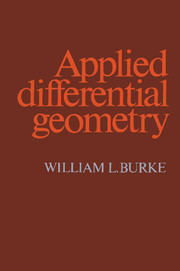Book contents
- Frontmatter
- Contents
- Preface
- Glossary of notation
- Introduction
- I Tensors in linear spaces
- II Manifolds
- III Transformations
- IV The calculus of differential forms
- V Applications of the exterior calculus
- VI Classical electrodynamics
- VII Dynamics of particles and fields
- VIII Calculus on fiber bundles
- IX Gravitation
- Bibliography
- Index
I - Tensors in linear spaces
Published online by Cambridge University Press: 05 June 2012
- Frontmatter
- Contents
- Preface
- Glossary of notation
- Introduction
- I Tensors in linear spaces
- II Manifolds
- III Transformations
- IV The calculus of differential forms
- V Applications of the exterior calculus
- VI Classical electrodynamics
- VII Dynamics of particles and fields
- VIII Calculus on fiber bundles
- IX Gravitation
- Bibliography
- Index
Summary
Linear spaces and the closely related affine spaces loom large in the literature of mathematics and physics. It is not just that only linear problems are easy to solve. The real reason lies in the fundamental idea of calculus: the local behavior of a smooth function can be represented by a linear function. Calculus is just the technology of these local linear approximations. The spaces in which these local approximations live are important linear spaces.
The most important linear space for us is the space of tangent vectors at a point. Elements of this space are local approximations to smooth curves passing through the point. Because of this, the tangent space, as it is called, is a local picture of the space itself. It is therefore easy to picture. Given any linear space there is an entire algebra of related linear spaces that comprise the various linear and multilinear operators. These operators are called tensors.
Closely related are affine spaces. These spaces have all the structure of a linear space, except that all points are equivalent. They lack a special point for the origin. These spaces are important because they form the arena for much of physical theory. Newtonian mechanics and special relativity are both set in an affine space. The straight lines and uniform parametrization model the uniform motion of free particles. In general relativity, this affine structure results because special relativity is a local approximation to general relativity.
- Type
- Chapter
- Information
- Applied Differential Geometry , pp. 11 - 50Publisher: Cambridge University PressPrint publication year: 1985

